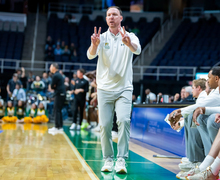SU’s focus on diversity is part of growing trend, but campus is still developing
In the past 10 years, Syracuse University has nearly doubled the amount of first-year students enrolled from low-income and minority backgrounds.
During Chancellor Nancy Cantor’s tenure, SU has become more diverse in racial, geographic and socioeconomic ways. In university discussions regarding the future of the university, some staff, faculty and students say a continuing emphasis on diversity is a quality they would like to see in SU’s next chancellor.
“The composition of the undergraduate student body has changed so dramatically over the past decade that I just think it’s remarkable,” said Don Saleh, vice president for enrollment management. “And it’s something that the institution, I believe, is proud of and should be proud of.”
Total enrollment has also increased, from 11,088 in 2002 to 13,905 in 2012, and SU has seen increases in diversity across the board.
- The number of students from the Northeast is dropping as more students from the Southern and Western United States and international locations are accepted. In fall 2002, 77 percent of students were from the Northeast. In fall 2012, it was 64 percent.
- In 2002, 16 percent of first-year undergraduate students were considered minority students. In 2012, that number increased to 31 percent. SU considers minority students to be students who identify as African-American, Asian-American, Native American or Latino.
- The number of first-year students who receive Federal Pell Grants has increased from 17 percent in 2002 to 26 percent in 2012. Federal Pell Grants are given to low-income undergraduate students and do not have to be repaid. Most Pell grant money goes to students with a total family income below $20,000.
Higher education studies suggest diversity is expected to increase in colleges across the United States.
The number of minority college applicants is expected to rise significantly, according to Knocking at the College Door, a regular report on demographic change published by the Western Interstate Commission for Higher Education. By the year 2020, minority students will account for 45 percent of public high school graduates, according to the report.
For Saleh, providing these opportunities to students is all part of the service a university should provide. Having a diverse campus means a complete education experience for students at SU, one that can prepare them for the real world.
A university serves the public good, and one way to do that is by offering a means for people to become educated and move up in the world, he said.
During the past eight years, the university has allocated more money into the financial aid budget, Saleh said. A portion of funds from SU’s Billon Dollar Campaign is also allocated for financial aid. Overall, financial aid for undergraduate students is slightly more than $200 million, Saleh said.
“Our goal always is to have the strongest financial aid packages we can afford. We can’t afford to do everything,” Saleh said
But for some students and university employees, just because there is diversity on campus does not mean there is a diverse campus.
James Duah-Agyeman, director of the Office of Multicultural Affairs, said everyone is responsible for making the university more diverse and embracing that diversity.
“Diversity is here,” Duah-Agyeman said. “Now what do we do with it?”
He said he sees students self-segregating themselves, and would like to see more students trying a club or class they would consider “outside of their comfort zone.”
However, as SU has accepted more diverse students, the university has also accepted more students in general. The acceptance rate increased from the low 50-percent range in the early 2000s to the 60-percent range in the later 2000s.
Some members of the higher education community say SU is ahead of the curve when it comes to admissions.
“The more applicants a college rejects, the more prestigious a college must be, or so the thinking goes among many observers of college admissions,” Eric Hoover, a senior writer for The Chronicle of Higher Education, wrote in his blog on admissions.
Hoover was responding to “Syracuse’s Slide,” an October 2011 article published in The Chronicle that described how SU, in an effort to provide more opportunities for the city and disadvantaged students, has fallen in national rankings.
Hoover said there are trade-offs that officials weigh during the admissions process.
“Generally speaking, enrolling more low-income students means emphasizing grades over ACT and SAT scores,” he wrote. “When a college enrolls more Pell-eligible students, it can expect to see standardized-test scores to go down.”
These changes do not mean sacrificing the academic quality of the institution, Hoover argued. The GPAs and SAT scores of incoming students have remained about the same under Cantor, according to university officials.
Some students say they feel they are considered academically inferior or tokenized because of race. At “Healing the Scars,” a panel discussion on campus diversity held in February, students in the audience spoke up to say these issues still need to be addressed.
Ronald Taylor, a sophomore political science and public policy major who organized the event, said he has encountered students behaving in a “juvenile” or ignorant way about different cultural backgrounds. As a freshman, he heard classmates who were not of African-American descent using the “N word” and saying it was acceptable because it was no longer viewed as a hurtful phrase.
Now that there is such a diverse student population, individuals need to act for themselves, Taylor said.
“College is about learning,” Taylor said. “Why would you come to sit in a bubble?”
Published on March 28, 2013 at 12:29 am
Contact Dara: dkmcbrid@syr.edu | @daramcbride






